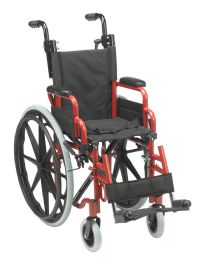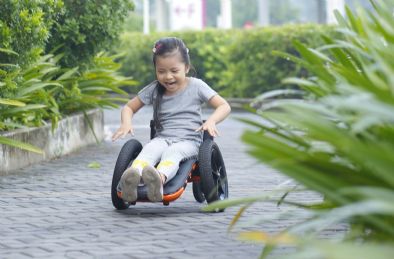
Pediatric wheelchairs provide mobility assistance for children of all ages.
Specifically designed to meet the many varied special needs of young users, these smaller versions of adult wheelchairs include a vast assortment of features and innovative designs to suit every unique child. Whether a child has cerebral palsy, autism, muscular dystrophy and other disabilities, or is recovering from an injury, illness or surgery that hinders ambulation, there is sure to be a perfect wheelchair match for every special young user.
Rehabmart is proud to offer an extensive collection of superior quality pediatric wheelchairs from such prominent and acclaimed manufacturers like Drive Medical, Invacare, Circle Specialty, Convaid, and Colours.







What is a Pediatric Wheelchair?
Just like regular wheelchairs, pediatric wheelchairs are available in a vast range of styles, sizes and configurations to more perfectly suit the needs of every unique child. They are constructed with smaller frames, with seats that are typically around 14 inches wide and 12 inches deep. They are generally set lower to the ground for easier access and added stability for the child. Unlike the antiquated versions of the past, today’s choices include a variety of innovative manual and powered pediatric wheelchairs that more completely fulfill a limitless spectrum of pediatric special needs.
Just as with any mobility device, it is highly recommended to consult with your child’s professional medical and therapy team before making a final decision on what kind of wheelchair to purchase. This helps to ensure the design will completely match up with your child’s unique requirements. The wheelchair should never hinder mobility for the child in any way. With so many models that are customizable and will even adjust as the child grows, there is no reason to settle on a wheelchair that does not conform to the young user’s needs.
Pediatric wheelchairs come in a variety of styles including standard/manual, lightweight/ultra-light, transport/folding, power/electric, tilt-in-space, alternative/recreational and ‘grow-with-your-child’. Other choices in this category include special needs strollers, mobility scooters and hand-cycle bikes.
How to Choose the Right Pediatric Wheelchair
While it may seem overwhelming to make a decision on what kind of wheelchair to choose for your child, there are basic selection criteria to determine that will help you narrow your search. Aside from the motility wheelchairs facilitate, many designs allow for a variety of positioning options that include laying and standing in addition to the usual sitting so that young users can move around comfortably. In addition to your consult with a medical professional to assess your child’s current physical abilities, health, size/ growth forecast and particular needs, here are some important questions to consider:
How and where will the wheelchair be used most often?
Does the wheelchair need to offer standing abilities?
Will the wheelchair require capabilities to navigate rough terrain or climb curbs or stairs?
What kinds of portability/transport options do you require for the wheelchair?
One of the most overlooked aspects of chair selection is if the wheelchair will appeal to the child. Because many users of every age regard their wheelchairs as extensions of themselves, your child must be comfortable with the style, color, functionality and performance. The look of the chair is one of the most important contributing factors to the young user’s self-image and expression of style.
Pediatric Wheelchair Models
From manual wheelchairs to powered wheelchairs, there are many design types to learn about in order to make the right selection for your child.
Manual Pediatric Wheelchairs
Dependent upon your child’s unique abilities, a manual wheelchair can be propelled with the legs, arms or a by a caregiver. Manual choices include transport/folding, lightweight/ultra-light, tilt-in-space, alternative/recreational and standing.
Manual transport chairs are portable and lightweight, making them highly convenient for utilization at doctor visits, school, child activity centers and any other indoor or outdoor places your child likes to roam. Specifically designed for active users, this durable design is well suited for children and families who tend to be on the go. Folding abilities allow for easier storage inside a vehicle.
Lightweight and ultra-light wheelchairs are also highly portable. Offering the utmost maneuverability in a manual chair, the lightness in weight helps weaker children to navigate more easily as there is less weight to move.
The manual tilt-in-space design is very popular with a lot of young users and their parents. Instead of simple reclines, these wheelchairs rotate the seat and back in place at different angles, allowing for enhanced positioning. The benefits to young users include the ability to maintain eye contact (instead of staring at a blank ceiling when reclined), enhanced digestion, relief and avoidance of pressure sores and optimal comfort.
Alternative and recreational wheelchairs are another option in manual wheelchair design. Generally purchased as an additional mobility device to the wheelchair that the child uses every day, these chairs are often particularly designed to more specifically address special user needs for recreation and other kinds of activities. These chairs can have larger tires and easier handling features for beach and all-terrain usage. Other pediatric mobility designs include a fun go-cart type, which a child sits in at ground level with outstretched legs and can self-propel, or be propelled by a friend or caregiver with the push handle on the back.
Power Pediatric Wheelchairs
If your child is unable to propel a manual wheelchair, a power chair should be your choice. Powered chairs come in a wide variety of designs with a plethora of varying features to ensure that every young user’s unique requirements are fulfilled with ease.
Just like manual wheelchairs for children, many powered versions offer capabilities to tilt-in-space, adjust seat heights, recline and stand. Power wheelchairs additionally offer a range of operational control options dependent upon the child’s abilities, such as joystick, push-button, head and chin switch, sip-n-puff, tiller and trackball.
Developmental and physical factors including visual perception, coordination and posture should always be assessed before deciding on what power model to purchase. Supervised training and practice is an absolute must with children who are learning to use a power wheelchair.
Power wheelchairs are heavier and bulkier than manual wheelchairs, so considerations about your family’s unique transportation requirements will need to be determined. Your vehicle must be big enough or have a special lift installed to transport the chair safely. And just like with manual models, a power wheelchair will require regular maintenance to ensure that it is kept in good working order at all times. The tires, braking system, battery, hardware and control system will all need to be tested regularly.
Power wheelchairs are available in three basic drive types. Front-wheel drive allows for tighter turning abilities, but may be slower in speed. Rear-wheel drive may be harder to navigate in small spaces, but provides faster speeds. Mid-wheel drive offers the best turning ability but may be less secure when the chair is started or stopped.
Grow-With-Your-Child Pediatric Wheelchairs
Both manual and power wheelchairs come in models that offer grow-with-your-child design. These special chairs offer adjusting capabilities and replacement components that help convert the chair into a larger size as your child grows. This adaptability saves money in the long run, as you don’t have to purchase a new chair every year or two as your child outgrows the old one.
Mobility Scooters and Strollers
As a delightful choice for children who have some limited walking abilities, mobility scooters afford them the opportunity to walk when they can, and sit when they can’t. They do require some modicum of arm function and upper body strength for the child to be able to steer, and the ability to transfer to and from the scooter.
As another fun option for pediatric mobility, hand-cycle bikes are popular with a lot of children of varying abilities. They often highlight sliding seats and flip-up footrests to make transfers easier.
Mobility strollers are a great choice for babies and toddlers with special needs, and highlight a multitude of features to more fully customize this equipment to each child. Most of these models are simple to fold down, transport and store as well.
Hulet Smith, OT
Rehabmart Co-Founder & CEO
ck